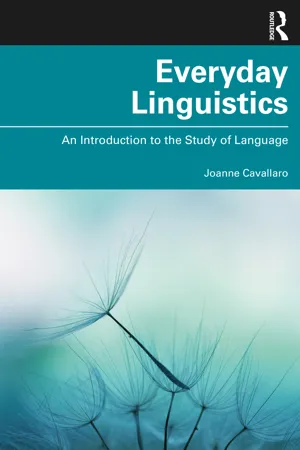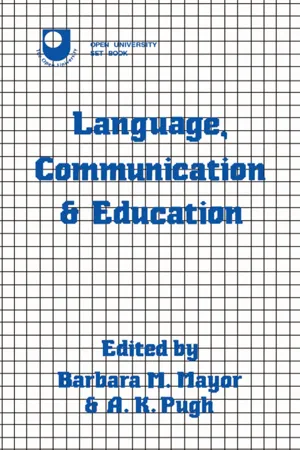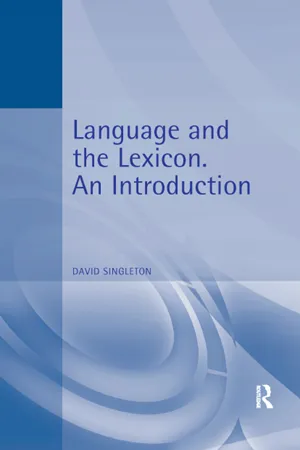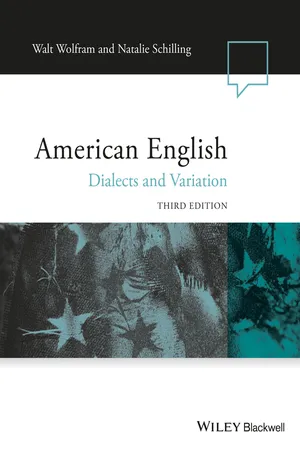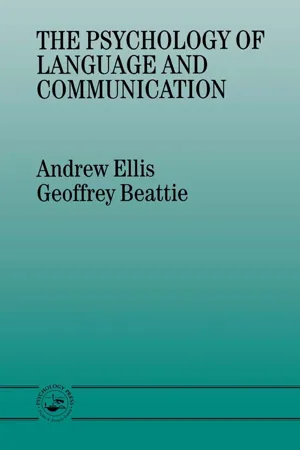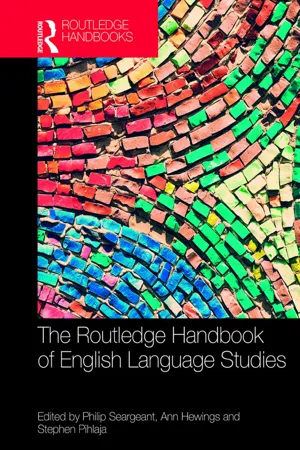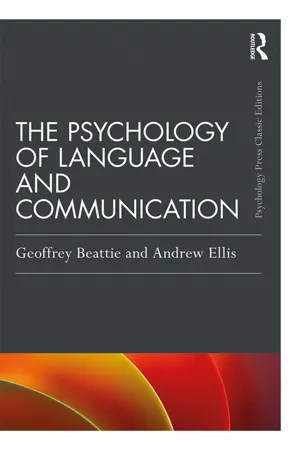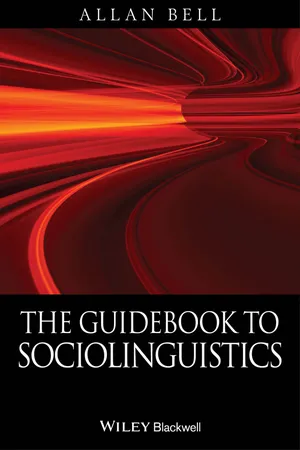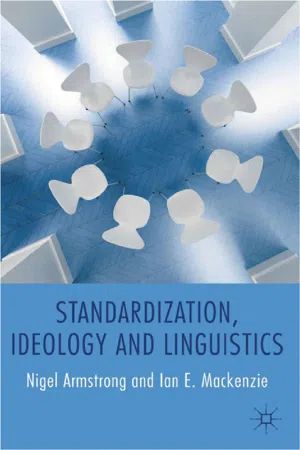Languages & Linguistics
Variety vs Standard English
Variety vs Standard English refers to the distinction between different forms of English used in various social, regional, and cultural contexts. Variety English encompasses the diverse dialects and vernaculars spoken by different communities, while Standard English represents the formal, widely accepted version of the language used in education, media, and official communication. This distinction highlights the dynamic nature of language and the importance of understanding and respecting linguistic diversity.
Written by Perlego with AI-assistance
Related key terms
10 Key excerpts on "Variety vs Standard English"
- eBook - ePub
Everyday Linguistics
An Introduction to the Study of Language
- Joanne Cavallaro(Author)
- 2023(Publication Date)
- Routledge(Publisher)
We’ve noted several times that all varieties of all languages are equally correct, valid and rule governed. And each variety of English has as much right to be called English as any other. We often subtly imply the opposite, however, through our labels. Calling a variety Hispanic English or Scottish English or working-class English implies that there is an English without a preceding adjective. There is not. The same holds true for other languages. Sicilian Italian is just as much Italian as what is called the standard. What most people consider the standard language is but one variety among many, granted one that is accorded prestige and respect. That term itself, standard language, is a misnomer, in fact. To be precise, it should be called a standard variety.The standard is sometimes defined as the variety used by those who have status and power. And its use confers status and power on those who use it. It is also said that those who use the standard are considered well-spoken and that the standard is defined as the variety used by those who are considered well spoken. If those definitions seem a bit circular to you, they are. The point here is that what we mean by a standard variety is hard to pin down. There is even disagreement among linguists as to whether or not it really exists. Some say it is an idealized variety that no one actually speaks; others say that speaking a standard is mostly about avoiding stigmatized features like double negatives or ain’t; still others that it is the native variety of the middle or upper-middle class. Still others term it a “mythical beast” (Lippi-Green, 2012 ).Standard varieties are generally defined as codified forms of a language that come to be accepted as the dominant variety and the only correct way of speaking. They are the varieties generally expected to be used by political leaders, mainstream media, and educated professionals—in other words, those with high levels of education, status, or authority. A standard variety fulfills certain functions outside those of everyday language: it is the variety used in formal writing, education, mass media, government, and most professional endeavors. It can serve as an emblem of nationhood and make communication across diverse languages easier. It can also, however, contribute to social inequality. - eBook - ePub
- Ronald Wardhaugh, Janet M. Fuller(Authors)
- 2021(Publication Date)
- Wiley-Blackwell(Publisher)
Part I Languages, Communities, and ContextsPassage contains an image
2 Languages, Dialects, and Varieties
KEY TOPICS
- The difference between a language and a dialect
- Defining a standard/standardized language
- Defining dialects by region: drawing geographical boundaries
- Development of social and ethnicized dialects
- How languages create meaning and how the meaning of languages is created
- Indexicality and entexualization
We stated in the introductory chapter that the concept of language is considered by many sociolinguists to be an ideological construct. Further, we noted that all languages exhibit internal variation, that is, each language exists in a number of varieties and is in one sense the sum of those varieties. We use the term variety as a general term for a way of speaking; this may be something as broad as Standard English, or a variety defined in terms of location and social class (e.g., ‘working‐class New York City speech’), or something defined by its function or where it is used, such as ‘legalese.’ In the following sections, we will explore these different ways of specifying language varieties and how we define the terms ‘language’ and ‘dialect’ (regional and social). We will also address how the associations between language and social meaning develop and are used in communicating in different speech contexts.What is a Language?
What do we mean when we refer to a language or, even more important, the idea of mixing languages? As we will discuss further in chapters 8 and 9 , recent research has coined many new terms to describe what has traditionally been called multilingualism – ‘(trans)languaging,’ ‘metrolingualism,’ ‘heteroglossia.’ These terms reflect the idea that languages are ideological constructs; while we (usually) have names for different ways of speaking and can describe their features, in practice linguistic boundaries may be fluid. Not only do many people mix languages, but in some contexts, language users do not recognize the linguistic elements they use as part of different codes but simply as a normal way of speaking (Jaspers and Madsen 2019 - eBook - ePub
- Barbara Mayor, A. K. Pugh(Authors)
- 2005(Publication Date)
- Routledge(Publisher)
Section 2 Standardisation and Diversity in LanguagePassage contains an image
Introduction
DOI: 10.4324/9780203975107-8We are often encouraged to think of a language as if it were a homogenous entity. This impression is confirmed by the strong pressures, notably nowadays from the educational system, towards conformity to national norms or standards, especially in written language. However, linguists observe that languages which are still spoken are always in a state of change. To some extent this is because of various pressures to speak in certain ways. The language of a national high-status group is not the only one which enjoys prestige in a country. There are other allegiances to be demonstrated and confirmed through language. Most speakers are able to vary their accent and even within one person the consistency implied by standardisation will be very hard to find. The readings in this section clarify these issues. They also examine the factors of a social or political nature which contribute to the adoption of certain forms or varieties of language.In the first article in this section, Leith traces the development of standard English in four stages which he suggests are applicable to the growth of other standard languages. The final stage, codification, involves an attempt to eliminate the variation which exists within a language and to stem change. Leith considers that standardisation is as complete as it is ever likely to be in English, yet there remains considerable diversity in pronunciation and still some variation in grammar and in written forms.Variation in pronunciation is the subject of an influential article by Giles which is our second reading here. In a series of studies, Giles examined the factors which cause us to value certain accents under certain conditions. This included research into whether one moves more towards or away from the accent of the person one is speaking to. We may, for example, move nearer to received pronunciation (RP) in certain circumstances and more towards a local or regional accent in others. Giles was particularly interested in how our judgements on people’s qualities are affected by our perception of their accent. He found that the status of received pronunciation is not so unambiguously high as might be assumed and that while some favourable qualities are attributed to speakers of RP, other positive qualities are perceived in speakers who use other accents. - eBook - ePub
Language and the Lexicon
An Introduction
- David Singleton(Author)
- 2016(Publication Date)
- Routledge(Publisher)
The social differentiation of English in Norwich (Cambridge: Cambridge University Press, 1974).Ethnic variation:V. Edwards, Language in a black community (Clevedon: Multilingual Matters, 1986);W. Labov, Language in the inner city: studies in the Black English vernacular (Philadelphia: University of Pennsylvania Press).Gender-related variation:J. Coates, Men, women and language: a sociolinguistic account of gender differences in language (London: Longman, 1993);S. Mills, Language and gender: interdisciplinary perspectives (London: Longman, 1995).Context-related variation:B. Myers-Scotton, Social motivation for code-switching (Oxford: Clarendon, 1993).Lexis, culture and thought:J. A. Lucy, Language diversity and thought: a reformulation of the linguistic relativity hypothesis (Cambridge: Cambridge University Press, 1992);A.Wierzbicka, Understanding cultures through their key words (Oxford: Oxford University Press, 1997).Focusing questions/topics for discussion1. In 7.3 we looked at some differences between American English words and their British English equivalents. Try to find some more examples of lexical differences between American English and British English and/or between any other two subvarieties of a language with which you are familiar.2. We saw in 7.4 that a number of attempts have been made to identify words or types of words which are particularly associated with particular social classes. Try to come up with some suggestions of your own in this connection – with reference either to English or to any other language you know.3. In 7.5 Belgium was mentioned as an example of a country where different ethnic groups – defined partly by language – live relatively separate from each other. Can you think of other countries where similar kinds of situations obtain? - eBook - ePub
American English
Dialects and Variation
- Walt Wolfram, Natalie Schilling(Authors)
- 2015(Publication Date)
- Wiley-Blackwell(Publisher)
In other words, vernacular varieties are the converse of standard dialects in that an assortment of marked English structures sets them apart as being vernacular. Not all speakers of a given dialect necessarily use the entire set of structures associated with their dialect, and there may be differing patterns of usage among speakers of the variety. In fact, attempts to isolate the common core of structures for a particular vernacular often lead to heavily qualified, imprecise descriptions. In Chapter 7, we will discuss the notion of ETHNOLINGUISTIC REPERTOIRE, where a fluid set of linguistic resources can be used to index linguistic identity of members of an ethnic group, offering an alternative to defining a unitary system that characterizes a community of vernacular speakers. We can summarize the features that set apart standard dialects and vernacular dialects as follows: F ORMAL S TANDARD ENGLISH: applied primarily to formal written language and formal spoken language situations; objective standards prescribed by language “authorities”; standards codified in usage books, dictionaries, and other written materials; conservative outlook on language forms. Targeted in prescriptive rules. I NFORMAL S TANDARD/MAINSTREAM ENGLISH: applied to spoken language and relatively informal written communications (e.g. emails); determined by actual usage patterns; recipient judgment essential in determining socially acceptable norms; multiple norms of acceptability, incorporating regional and social considerations; defined by the relative absence of socially stigmatized linguistic structures. V ERNACULAR ENGLISH applied to spoken language and informal written communications (e.g - eBook - ePub
- Geoffrey Beattie, Andrew Ellis(Authors)
- 2014(Publication Date)
- Psychology Press(Publisher)
6Variation within a languageIn the last chapter we considered the diversity of different languages. Now we wish to consider possible diversity within a single language. Diversity within a language may be due to geographical location, class, sex or ethnic background.Geographical location is perhaps the most obvious – the English spoken in Surrey is different from the English spoken in Belfast or Glasgow, or New York or South Carolina. Sometimes accent makes the speech mutually unintelligible. Geographical location principally affects pronunciation but clearly there are other differences as well, for example in word usage or grammar. A variety of language which is grammatically different from any other (as well, perhaps, as having a different vocabulary or pronunciation) is called a dialect. Dialects are defined in terms of grammar, which means that speakers can employ colloquial styles of speech including slang or swear-words (for example in a very informal context) and still be using standard English. As Peter Trudgill points out:‘“I'm bloody knackered” may be part of a conversation in standard English (in an informal style, of course) while, “I be very tired” cannot be considered as an example of the standard English dialect’ (1975, p. 19).Standard English is itself a dialect and like all other dialects is subject to regional variation. Consider the following grammatical contrasts between American, Scottish and English Standard English:American standard English: ‘He'd gotten it’ English standard English: ‘He'd got it’ Scottish standard English: ‘You had a good time, hadn't you’ English standard English: ‘You had a good time, didn't you’ (from Trudgill, 1975, p. 18).Certain grammatical features are very characteristic of specific regional dialects. Thus: ‘I wants it’ is characteristic of the West Country; ‘He want it’ is characteristic of East Anglia.Words common in one regional dialect may never have been heard of in another. For example, in the South of England they make a pot of tea; in the North, in many dialects, they may ‘mash’ a pot of tea. (In the South they may mash potatoes but definitely not tea). - Philip Seargeant, Ann Hewings, Stephen Pihlaja(Authors)
- 2018(Publication Date)
- Routledge(Publisher)
The key area of dispute, particularly among language scholars, involves the nature of Standard English – which is a specific instantiation of a more general question concerning the nature of standards in language. This is not to say that such disputes do not take place in policy contexts or in society in general. But when such disputes occur in these latter domains, there is usually a presumption that language experts can provide a clear resolution to the matter; hence, there can be impatience and frustration when these experts do not agree among themselves or when they try to explain why the issue is actually a matter of some complexity.Basically, the main question relates to how seriously to take the notion of language change and therefore whether to conceive of Standard English as primarily a product or a process. This relates to another area of dispute, which is whether to understand the nature of Standard English in primarily linguistic or non-linguistic terms, where adopting the latter means giving serious recognition to the influences of social and political factors.No one would deny that the English language has undergone changes in grammar, lexis, and pronunciation. The issue therefore is to what extent such changes are considered negligible, such that the language can be said to be fundamentally the same. Once we acknowledge that what counts as standard inevitably changes because of the variation that inheres in the language practices of different speakers, and moreover, that there are ideological influences at work in deciding just what kind of variation to accept as being standard and what to reject as being non-standard, then we have to also acknowledge the inescapable relevance of non-linguistic factors in defining Standard English and, more generally, standards in English. In this regard, recall that Honey insists on ‘educatedness’ (1997: 235) as the hallmark of Standard English speakers, though he also allows for other, sufficiently ‘high-status’ individuals or circumstances (1997: 161–162):- eBook - ePub
- Geoffrey Beattie, Andrew W Ellis(Authors)
- 2017(Publication Date)
- Routledge(Publisher)
Variation within a LanguageIn the last chapter we considered the diversity of different languages. Now we wish to consider possible diversity within a single language. Diversity within a language may be due to geographical location, class, sex or ethnic background.Geographical location is perhaps the most obvious – the English spoken in Surrey is different from the English spoken in Belfast or Glasgow, or New York or South Carolina. Sometimes accent makes the speech mutually unintelligible. Geographical location principally affects pronunciation but clearly there are other differences as well, for example in word usage or grammar. A variety of language which is grammatically different from any other (as well, perhaps, as having a different vocabulary or pronunciation) is called a dialect. Dialects are defined in terms of grammar, which means that speakers can employ colloquial styles of speech including slang or swear-words (for example in a very informal context) and still be using standard English. As Peter Trudgill points out:‘I’m bloody knackered’ may be part of a conversation in standard English (in an informal style, of course) while, ‘I be very tired’ cannot be considered as an example of the standard English dialect.(1975, p. 19)Standard English is itself a dialect and like all other dialects is subject to regional variation. Consider the following grammatical contrasts between American, Scottish and English Standard English:Certain grammatical features are very characteristic of specific regional dialects. Thus:American standard English: ‘He’d gotten it’ English standard English: ‘He’d got it’ Scottish standard English: ‘You had a good time, hadn’t you’ English standard English: ‘You had a good time, didn’t you’(from Trudgill, 1975, p. 18)‘I wants it’ is characteristic of the West Country; ‘He want it’ is characteristic of East Anglia.Words common in one regional dialect may never have been heard of in another. For example, in the South of England they make a pot of tea; in the North, in many dialects, they may ‘mash’ a pot of tea. (In the South they may mash potatoes but definitely not tea). - eBook - ePub
- Allan Bell(Author)
- 2013(Publication Date)
- Wiley-Blackwell(Publisher)
- Class was operationalized in Labov’s work through indexes of occupation, education, income, etc. Most major sociolinguistic surveys followed this kind of structural-functionalist model, which implies a consensus of all classes agreeing on their evaluation of sociolinguistic differences.
- Opposing vernacular norms also pull speakers towards non-standard forms. This is better explained in the alternative, conflict theory of class associated with Marx. Linguistic and social stratification involve inequality and disadvantage. The conflict approach fitted the structures and conditions in Rickford’s study of a sugar-cane village in Guyana.
- Ethnicity involves a group’s shared sociocultural characteristics. In ethnolinguistic variation a minority group speaks a distinctive variety of the dominant language because of influence from features of their heritage language. Such differences are usually matters of degree rather than absolutes.
- African American Vernacular English has been the most researched of all language varieties since studies of inner-city youth in the 1960s. Continuing research has detailed the linguistic features and social significance of AAVE, disputed its origins, and contributed to public debate on its relation to educational disadvantage. Ethnic varieties of English have been researched in many countries, including Australia, the United States and New Zealand.
- Gender is a major influence on language choice. Although there are communities where women and men use different varieties or forms, usually gender differences are a matter of degree.
- Labov proposed the generalization that women use more prestige variants of stable sociolinguistic variables. One explanation is that women are more status-conscious than men, but others argue that they are more bound to status because of their lack of power. Gender interacts with other social dimensions like ethnicity, class and age, as in the Cajun English of Louisiana.
- ING has been the most researched linguistic variable around the world over the past 60 years. Its variation patterns by class, style, and especially gender. The non-standard variant in
- eBook - ePub
- N. Armstrong, I. Mackenzie(Authors)
- 2012(Publication Date)
- Palgrave Macmillan(Publisher)
1The nature of the standard
In this chapter we attempt to characterize the essential features of standard languages. In the interests of clear exposition we set out these features below in separate sections, although it will be seen that they overlap. These features of the standard refer to the following attributes: the standard as an ideology, which includes beliefs about its beauty, logical nature and efficiency; the socially dominant variety; the overlay acquired subsequent to the vernacular; the synecdochic variety; that which is regionless. We then look at some examples of folk-linguistic perceptions of the standard, before considering more closely the essential characteristics of ideologies as they concern us here.1.1 The standard as an ideology
Milroy and Milroy (1999) suggest that a standard language is an abstraction, or more specifically, since all languages are abstractions, an ideology. The terms ‘standard’ and ‘non-standard’ are of course used by specialists in an ostensibly value-neutral sense, even if this specialized use of these terms does not match with their everyday currency; but normative terms like ‘sub-standard’, among many others, are frequent among linguistically naive speakers who have absorbed the ‘ideology of the standard’ (Milroy and Milroy 1999), which sees the standard as the only language worthy of the name, and the associated non-standard varieties as imperfect approximations to it. One view current in sociolinguistics sees standardization as a form of cultural oppression, most obviously by the upper classes, and indeed it is hard from this viewpoint to see the social advantage accruing to most speakers through their acceptance of the ideology of the standard. The notion of this ideology also explains style variation, which is linguistic accommodation determined by social situation; very few speakers enjoy such linguistic security that they can neglect to adapt their speech to someone of different social status, and this is the root of stylistic or situational variation. L. Milroy (2003: 161) cites Silverstein’s (1979: 193) definition of language ideologies, which is as follows: they are ‘sets of beliefs about language articulated by users as a rationalization or justification of perceived language structure and use’. The view we adopt in this book is that standardization is the expression of a broader ideology, to do with a hierarchical, as opposed to an egalitarian, view of how society should be ordered. From that perspective, the sets of beliefs alluded to in Silverstein’s definition of language ideologies can be understood as ‘second-order’ ideologies, such that, in a fairly obvious way, the standard borrows prestige from the power of its users. Less obviously perhaps, the perceived invariance of the standard derives too from the hierarchical viewpoint that opposes change.
Index pages curate the most relevant extracts from our library of academic textbooks. They’ve been created using an in-house natural language model (NLM), each adding context and meaning to key research topics.
